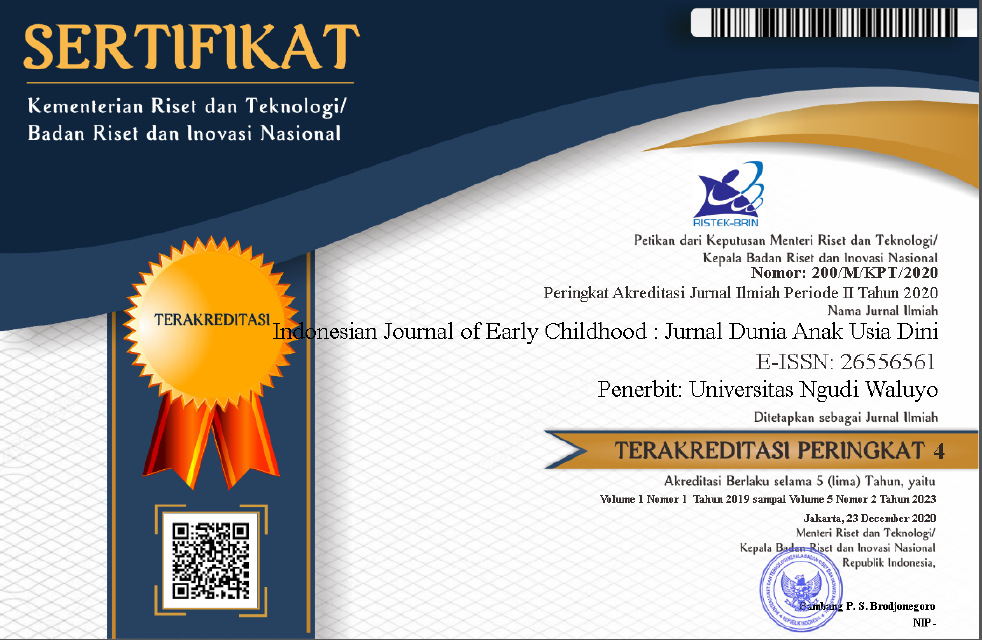Pengembangan Instrumen Pengukur Keterampilan Guru dalam Mengajar Berbasis Media Pembelajaran (Loose Part) di Lembaga PAUD Jawa Tengah
Development of Teacher Skill Measurement Instruments in Teaching Based on Learning Media (Loose Part) in PAUD Institutions in Central Java
DOI:
https://doi.org/10.35473/ijec.v7i1.3233Abstract
Early childhood children are great imitators and active learners where children build knowledge by playing and always active in exploring new knowledge, and have a high curiosity. Game media loose parts is a game material that can be moved, combined, and redesigned in various ways. This research is research Research and development (R&D) by developing instruments to measure teacher skills in teaching based on learning media (loose parts)The aim is to find out valid and reliable instruments. The subjects in this research were 34 PAUD institution teachers located in Central Java. The statement instrument developed consisted of 10 items to be tested, the results of data analysis using the Jamovi application version 2.4.14 in items number 1 to number 10 it is more than (>) 0.3291, meaning that the instrument is said to be valid, based on the analysisdata Item Reliability Statistics from item 1 to item 10 it is more than(>) 0.6 then the instrument can be said to be reliable, seen from the tableScale Reliability Statistics Cronbach's α there is 0.761 with an Average (Mean) of 7.87%, then the instrumentmeasuring teacher skills in teaching using media (loose parts) good for use in the field and can be developed by students.
ABSTRAK
Anak usia dini sebagai peniru yang ulung dan pembelajar aktif dimana anak tersebut membangun pengetahuan melalui bermain dan selalu aktif menggali berbagai pengetahuan baru, serta memiliki rasa ingin tahu yang tinggi Media permainan loose parts merupakan suatu bahan permainan yang dapat dipindahkan, digabungan, dan dirancang ulang dengan berbagai cara. Penelitian ini merupakan penelitian Research and development (R&D) dengan mengembangkan instrumen pengukur keterampilan guru dalam mengajar berbasis media pembelajaran (loose parts),tujuannya untuk mengetahui instrumen yang valid dan reliabilitas. Subyek dalam penelitian ini guru lembaga PAUD berlokasi di jawa tengah dengan jumlah 34 orang. Instrumen pernyataan yang dikembangkan terdiri 10 item untuk diujikan, hasil analisis data menggunakan aplikasi Jamovi versi 2.4.14 pada item nomor 1 sampai dengan nomor 10 sudah lebih dari (>) 0,3291 artinya instrumen tersebut dikatakan valid, berdasarkan analisis data Item Reliability Statistics dari item 1 sampai dengan item 10 sudah lebih dari (>) 0,6 maka instrumen dapat dikatakan reliabilitas, dilihat dari tabel Scale Reliability Statistics Cronbach's α terdapat 0,761 dengan Rata-rata (Mean) 7,87%, maka instrumen pengukur keterampilan guru dalam mengajar menggunakan media (loose parts) baik digunakan di lapangan dan dapat dikembangkan pada siswa.
References
Anita Damayanti, Sriyanti Rahmatunnisa, & Lia Rahmawati. (2020). Peningkatan Kreativitas Berkarya Anak Usia 5-6 Tahun Melalui Pembelajaran Jarak Jauh Berbasis Steam Dengan Media Loose Parts. Jurnal Buah Hati, 7(2), 74–90. https://doi.org/10.46244/buahhati.v7i2.1124
Badriyah, E. S. (2022). Penggunaan Media Loose Part dalam Mengembangkan Aspek Kognitif Anak Usia Dini. Jurnal Tumbuh Kembang Anak Usia Dini, 1(3), 2.
Fransiska, Y., & Yenita, R. (2021). Penggunaan Media Loose Parts dalam Pembelajaran di Masa Pandemi. Jurnal Pendidikan Tambusai, 5(8), 5454–5462.
Kulsum, U. (2022). Upaya Peningkatan Kemampuan Kognitif Anak Melalui Media Loose Parts. Jurnal Ilmiah Cahaya Paud, 4(1), 60–66. https://doi.org/10.33387/cp.v4i1.4046
Kurnia, A., & Nasrudin, D. (2022). Mengukur Efektivitas Pelatihan Implementasi Pembelajaran STEAM- Loose Parts pada Guru PAUD. Jurnal Obsesi : Jurnal Pendidikan Anak Usia Dini, 6(4), 3727–3738. https://doi.org/10.31004/obsesi.v6i4.2372
Leonia, R. A., Handayani, T., & Putri, Y. F. (2022). Pengaruh Media Loose Part Terhadap Kemampuan Pra Menulis Anak Pada Kelompok B. Jurnal PG-PAUD Trunojoyo : Jurnal Pendidikan Dan Pembelajaran Anak Usia Dini, 9(2), 9–17. https://doi.org/10.21107/pgpaudtrunojoyo.v9i2.14058
Mita Oktavia & Abdul Karim Halim, 2022. Penggunaan Media Loose Part dalam Mengembangkan Kreativitas Anak Usia Dini di PAUD Tunas Harapan. DOI: https://doi.org/10.24036/jfe.v2i3.69
Nurjanah, S., & Muthmainah, M. (2023). Pengaruh Media Loose Part terhadap Kreativitas dan Motorik Halus Anak Usia Dini. Jurnal Obsesi : Jurnal Pendidikan Anak Usia Dini, 7(3), 3519–3536. https://doi.org/10.31004/obsesi.v7i3.4434
Nurseto, T. (2012). Membuat Media Pembelajaran yang Menarik. Jurnal Ekonomi Dan Pendidikan, 8(1), 19–35. https://doi.org/10.21831/jep.v8i1.706
Rahma, B. A., Kustiono, K., & Setiawan, D. (2023). Penerapan Merdeka Belajar dengan Media Berbahan Loose Part pada Anak Usia Dini. Jurnal Obsesi : Jurnal Pendidikan Anak Usia Dini, 7(4), 3991–4001. https://doi.org/10.31004/obsesi.v7i4.4926
Rosanaya, S. L., & Fitrayati, D. (2021). Pengembangan Media Pembelajaran Berbasis Video Animasi pada Materi Jurnal Penyesuaian Perusahaan Jasa. Edukatif : Jurnal Ilmu Pendidikan, 3(5), 2258–2267. https://edukatif.org/index.php/edukatif/article/view/785
Safitri, D., & Lestariningrum, A. (2021). Penerapan Media Loose Part untuk Kreativitas Anak Usia 5-6 Tahun. Kiddo: Jurnal Pendidikan Islam Anak Usia Dini, 2(1), 40–52. https://doi.org/10.19105/kiddo.v2i1.3645
Sahrul, et al, (2022) Development of Instruments to Measure Self-Confidence and Creative Thinking in Mathematics Learning for Vocational High School Students Journal of Research and Educational Research Evaluation JRERE 11 (1) 2022 81-92 http://journal.unnes.ac.id/sju/index.php/jere
Sahrul, et al, (2022) Evaluasi Hasil Belajar SiswaMata Pelajaran MatematikaPada SMPN 1 Sape Kabupaten Bima. http://pps.unnes.ac.id/pps2/prodi/prosiding-pascasarjana-unnes.
Syaifudin Azwar 2017. Uji Validitas dan Reliabilitas. Pustaka Pelajar. Yogyakarta
Valentina Dewi, E. R., Hibana, H., & Ali, M. (2023). Pengaruh Penggunaan Media Loose Parts terhadap Perkembangan Kognitif Anak Usia Dini. Jurnal Obsesi : Jurnal Pendidikan Anak Usia Dini, 7(1), 267–282. https://doi.org/10.31004/obsesi.v7i1.3451
Downloads
Published
How to Cite
Issue
Section
License
Copyright (c) 2025 Indonesian Journal of Early Childhood: Jurnal Dunia Anak Usia Dini

This work is licensed under a Creative Commons Attribution-ShareAlike 4.0 International License.
Please find the rights and licenses in Indonesian Journal Of Early Childhood: Jurnal Dunia Anak Usia DIni. By submitting the article/manuscript of the article, the author(s) agree with this policy. No specific document sign-off is required.
1. License
The non-commercial use of the article will be governed by the Creative Commons Attribution license as currently displayed on Creative Commons Attribution-ShareAlike 4.0 International License.
2. Author(s)' Warranties
The author warrants that the article is original, written by stated author(s), has not been published before, contains no unlawful statements, does not infringe the rights of others, is subject to copyright that is vested exclusively in the author and free of any third party rights, and that any necessary written permissions to quote from other sources have been obtained by the author(s).
3. User Rights
Indonesian Journal Of Early Childhood: Jurnal Dunia Anak Usia Dini's spirit is to disseminate articles published are as free as possible. Under the Creative Commons license, Indonesian Journal Of Early Childhood: Jurnal Dunia Anak Usia Dini permits users to copy, distribute, display, and perform the work for non-commercial purposes only. Users will also need to attribute authors and Indonesian Journal Of Early Childhood: Jurnal Dunia Anak Usia Dini on distributing works in the journal and other media of publications.
4. Co-Authorship
If the article was jointly prepared by more than one author, any authors submitting the manuscript warrants that he/she has been authorized by all co-authors to be agreed on this copyright and license notice (agreement) on their behalf, and agrees to inform his/her co-authors of the terms of this policy. Indonesian Journal Of Early Childhood: Jurnal Dunia Anak Usia Dini will not be held liable for anything that may arise due to the author(s) internal dispute. Indonesian Journal Of Early Childhood: Jurnal Dunia Anak Usia Dini will only communicate with the corresponding author.
5. Miscellaneous
Indonesian Journal Of Early Childhood: Jurnal Dunia Anak Usia Dini will publish the article (or have it published) in the journal if the article’s editorial process is successfully completed. Indonesian Journal Of Early Childhood: Jurnal Dunia Anak Usia Dini's editors may modify the article to a style of punctuation, spelling, capitalization, referencing and usage that deems appropriate. The author acknowledges that the article may be published so that it will be publicly accessible and such access will be free of charge for the readers as mentioned in point 3.
Â
Every accepted manuscript should be accompanied by "Copyright Transfer Agreement" prior to the article publication.



